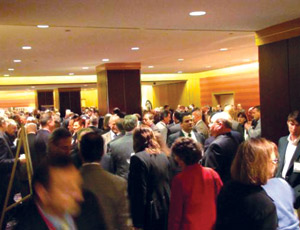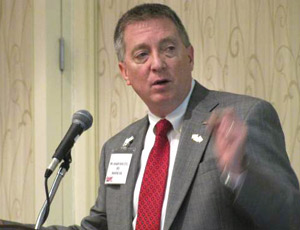The potential for new business in military and federal construction lured a record number of industry executives to the Society of American Military Engineers' annual agency briefing in Crystal City, Va., on March 23. However, congressional budgetary wrangling and changing military contracting trends did not leave all attendees gleeful.


Civilian and military construction chiefs noted that budget uncertainties, including a possible halt to traditional congressional project “earmarks,” hampers efforts to deliver more construction work into attendees’ hands. Terry G. Edwards, director of the Air Force Center for Environmental Excellence (AFCEE), told the packed house of more than 600 attendees that 77% of its fiscal 2011 construction program has been advertised and 53% is ready for award. “But until we get funding, we’re kind of on hold,” he said.
Edwards said, “[AFCEE] has been successful so far in getting contractors to extend their bids from 30 to 90 days.” However, he admitted bid costs were going up. “The pendulum is swinging from the really good days of low bids,” Edwards noted. “There’s not as much money on the table as in past years.” Attendees raised concerns about potential contracting jams when budgets are finally released, but Edwards said AFCEE did not expect “a big queue.” Please click here to link to presentations and the attendee list.
With pressure on the U.S. Dept. of Defense to cut operational costs, officials noted the need for new “efficiencies.” Lt. Col. John J. Allen, Air Force programs division chief for logistics, installations and mission support, said, “We still need to do work for new missions, but we can’t fund it all each year.” Edwards predicted “fewer” military construction projects ahead, but said “new efficiencies may have a milcon tail.”
Robert Slockbower, military programs director for the U.S. Army Corps of Engineers, noted the approaching end, by Sept. 30, of the military’s $14-billion multiyear base realignment and closure (BRAC) program, but said a growing emphasis on “overseas contingency operations” could take up some of the slack. “We will be engaged in it a long time,” he said, noting more infrastructure rebuilding in Afghanistan. “There will be a significant workload in the next two years, and it will be fully funded,” he said.
Slockbower noted a downward spike in work generated by military “transformation,” which is budgeted at $7 billion in fiscal 2011, “the Corps’ second-largest program,” but will be $1.5 billion in fiscal 2012. Slockbower said work related to facility modernization “will be there for a long period of time.”
Slockbower pointed to the military’s “paradigm shift.” The Corp official said, in the BRAC era, “We were focused on military programs. Now we’re looking at military missions, a suite of new requirements.” Slockbower compared the Corps staff to “imagineers,” the Disney Corp.’s troupe of engineers and technical experts, saying, “We are providing ‘solutioneers,’ ”
George Lea Jr., chief of the Corps construction division, noted continuing changes in Corps standards and approaches. The room burst into applause when he noted the Corps decision late last year to move to a platform-neutral approach to building information modeling software for its standardized designs, a reversal of a requirement unpopular with industry that only Bentley Systems Inc. software be used. The change could benefit Autodesk and its Revit line of BIM modeling software used by AEC firms.
“The real story here is that Bentley, the Corps, and Autodesk have been hard at work advancing interoperability, and everyone benefits. We support native RealDWG in our V8i generation of products and AutoCAD 2012 will natively support Bentley’s DGN format,” said Huw Roberts, Bentley global marketing director for building and structural engineering, in a statement. “Our recently announced iWare Apps provide free interoperability between Autodesk’s Revit and Bentley BIM applications because we believe that this is not a zero-sum world. Engineering contractors benefit from extended choice, the Corps benefits through data reuse, and as software providers, we benefit by increasing the value of information modeling to our users. Everybody wins.”
Lea also noted plans to set new criteria to that would weigh building life cycle costs in proposals. "We're pushing this out to project designers, but builders will not be off the hook either," he said. He added there would be more emphasis on net-zero energy use with the Corps set to announce this month or next five Army bases to become net-zero energy installations.
Joseph E. Gott, chief engineer for the Naval Facilities Engineering Command, noted that the agency’s proportion of design-build has fallen to 62%, below its previous proclaimed level of 75%. “This is because of large projects,” he said. But Gott acknowledged NAVFAC’s shift to more in-house engineering so staffers, particularly more recent hires, “could touch a little more design.” He said NAVFAC was not sure yet of how it will use total ownership costs as a proposal evaluation factor, “but we will look for it.”
NAVFAC officials were uncertain as to how Japan’s earthquake and the huge rebuilding effort ahead would affect its previous pledge to fund environmental infrastructure upgrades on Guam, to enable transfer of military personnel there from Okinawa under a 1990s treaty. Gott said the situation “was very fluid.” He said the military is “pressing ahead” on its construction schedule there. NAVFAC Rear Adm. Christopher Mossey reiterated the two countries’ continued commitment to relocation, but Gott said “projects will slide to the right. I don’t think the Japanese government has had time to give us guidance.”
“I think the Japan disaster will have a long-term effect on the Guam buildup,” said one design firm executive and former Navy officer. “It will slow down the process but it could also speed up the process if the government needs new space for its displaced population from northeast Japan. Time will tell.”
According to another executive attendee, a senior U.S. Navy official involved in the Guam program told an industry group earlier in March that the earthquake impact would “more than likely be causing a ripple effect” in the country’s focus on its funding for the military transfer.
Attendees were also chagrined by signs of more design in-sourcing. “I am very worried about the continued emphasis on moving back from design-build to the traditional design-bid-build delivery method,” said one executive. “I know they do not believe this is a better use of taxpayer money; it just pays the bills during the budget gaps. I also sense the feds are really tired of the budget and spending battles. The hoops they have to jump through with each [continuing resolution] and year-end scenario eats away at their productive time.”
The executive anticipates “two more years of good programs. But with elections pending, the Middle East crisis escalating and the Japan devastation looming, I’m not sure anyone truly knows where this will land. Everyone just wants to keep up and not get left behind.”

Post a comment to this article
Report Abusive Comment